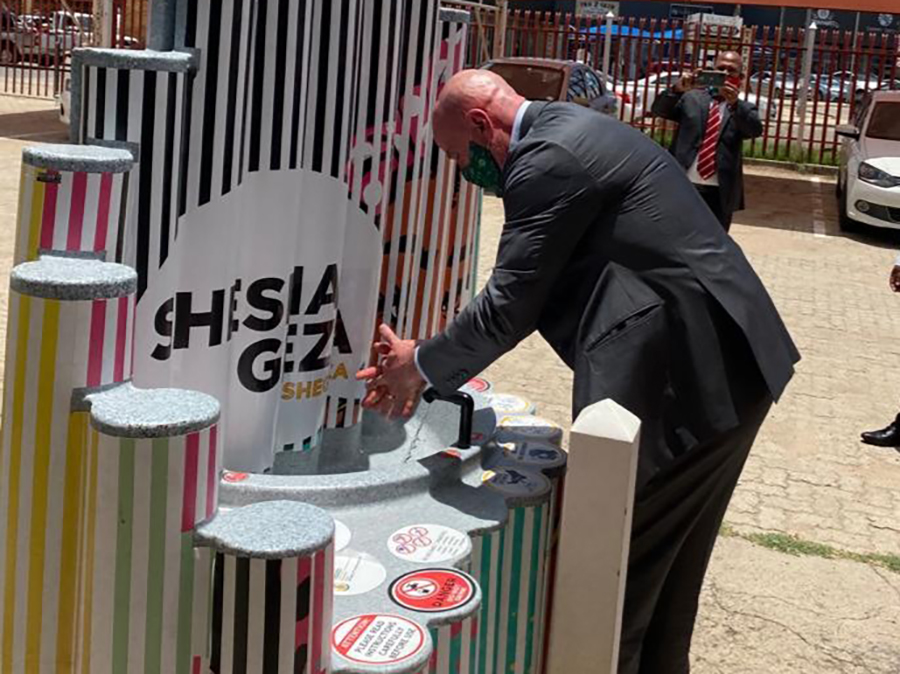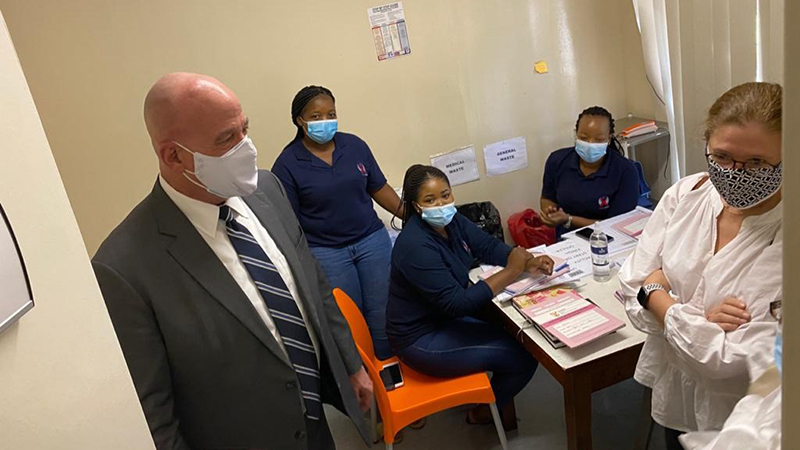A Tale of Two Countries During COVID-19, Part Two: South Africa
A Conversation with CDC’s Former Vietnam and current South Africa Country Director, John Blandford, PhD
During the past year, John Blandford, PhD, has been in the unique position to witness and support the global COVID-19 pandemic response as a CDC country director in not one but two parts of the world: Vietnam and South Africa. Given his firsthand experience in these two countries with very different pandemic experiences, we asked Dr. Blandford to spend a few minutes with us and share some of his observations in a two-part series. Part 1 reflects his experience in Vietnam.
Moving from Vietnam to South Africa in 2020
You left Vietnam in the Summer of 2020 to assume the post of country director in South Africa. How did that go?
Blandford: I did a direct transfer between Vietnam and South Africa because it wasn’t practical to return to the United States first due to the COVID-19 situation.
So, I moved to Pretoria on August 28 and went into two weeks of quarantine before I could emerge and fully engage as CDC’s new country director in South Africa.
I was just thinking about the contrast again between the COVID-19 situation in Vietnam when I departed compared to that in South Africa when I landed. At my going-away party in Hanoi, we were on an outdoor deck with the ambassador, some key folks from the embassy and from CDC – nobody wore masks. There was no need at the time because there was no community transmission in Vietnam.
Then we came to Pretoria, and we’re in full lockdown and in a completely different environment.
Just as we were emerging from our travel quarantine, South Africa was emerging from the extended lockdown of its first epidemic wave.

Dr. John Blandford, CDC South Africa Country Director, tests the Shesha-Geza hand hygiene station outside the Lonely Park Clinic in Mahikeng, North West Province. Shesha-Geza is an innovative handwashing solution installed at health facilities to help thousands of people prevent transmission of COVID-19 by washing their hands.
Photo by Melissa Briggs-Hagen/CDC
How was the situation in South Africa different from Vietnam?
Blandford: South Africa was in an extended lockdown. The closing of non-essential businesses had a big impact on the economy, similar to what we saw in the United States.
One interesting strategy in South Africa was to halt all liquor sales to free up hospital beds, especially the ICU beds, for COVID-19 patients.
There are clear associations between liquor sales and alcohol-related injuries caused by drunk driving and domestic violence. After months of banned liquor sales, we saw massive declines with both those issues.
South Africa is an upper middle-income country with more resources than Vietnam, but certainly nowhere near the resources of the United States, and they had a pretty effective response, too. They were able to get the COVID-19 rates down with good application of public health measures. That’s not so say that they don’t have challenges, too. Like in the United States, achieving consistent mask usage and social-distancing measures can be challenging.

Blandford, the CDC’s South Africa country director, visits the Xhora Community Health Centre in the Eastern Cape with Professor Harry Hausler, Chief Executive Officer of TB HIV Care; Sandile Prusente, TB HIV Care and Treatment Program Manager; and Rayna Taback-Esra, Deputy Director for Programs at CDC South Africa.
Photo by Refilwe Sello/CDC
Compared to Vietnam, what were some of the challenges you encountered when you arrived in South Africa?
Blandford: Well, in hindsight, I would not recommend changing jobs in the middle of an infectious disease epidemic – especially if your job is trying to prevent different infectious diseases, like HIV and TB.
I’ve had more limited opportunities since my arrival because my mobility has been restricted due to COVID-19. I haven’t been out doing site visits, something I normally would have done as the new CDC country director. This is one of the things that makes this transition really hard. I’ve had to do all my introductions virtually due to COVID-19. Normally, I would have been personally meeting all my counterparts at the Ministry of Health. I would have been meeting the key folks in the civil society, the HIV advocates. Those are all important relationships to establish within the first weeks and months of coming into a new position like this, and all of that’s been done virtually.
I met all my staff literally like this: on video conferencing calls. CDC South Africa is a big office of 130 people. It’s hard enough to feel like you start to know everybody and can identify folks – you know – by face and name, and it’s just been a real challenge getting settled in and feeling kind of the same sort of ownership in the space. So, it’s been challenging. It’s harder to feel like you’re completely engaged and wholly part of the strong team that’s already here.
How does CDC Vietnam differ from CDC South Africa?
Blandford: I think one of the differences between the offices in Vietnam and South Africa is that this office where I am now is the largest CDC PEPFAR program in the world. We have a very large staff and a large budget. We have a primarily locally employed staff, which is the foundation of CDC country offices, but we also have a substantial U.S. staff here as well. I will say the difference compared to Vietnam is this office is almost entirely focused on HIV and TB. We also have a small but critical influenza program.
How has CDC been able to assist South Africa in the pandemic response?
Blandford: CDC has a close relationship through the influenza team with a focus on respiratory diseases. They worked closely with South Africa’s National Institute of Communicable Diseases. Critical to that relationship was our influenza director Dr. Meredith McMorrow. Given her expertise and relationship, she stepped up to really lead the COVID-19 response for CDC in South Africa.
At the beginning of the pandemic, Dr. McMorrow was an important resource in a time of a lot of uncertainty. We typically have good relations with the local department of health. It’s also critical to have those sorts of specific relationships that are not just tied to the HIV program, but also relationships in respiratory diseases, in pandemic preparedness or emergency response, and laboratory support.

TB HIV Case Managers at Xhora Community Health Centre brief Blandford, CDC’s South Africa Country Director about the strategies they use to bring back people to care after the negative impact of COVID-19 on people getting antiretroviral therapy.
Photo by Refilwe Sello/CDC
When it comes to South Africa and COVID-19, most people probably think of the variant strain – B.1.351 – which was first identified in this country. How was that variant discovered?
Blandford: South Africa was already well prepared. It has a strong medical system, and very strong laboratory capacity. When I think about the South Africa variant, I think that’s actually a tribute to the system here – to the caliber of the science in South Africa. We don’t know for a fact that the South Africa variant started in South Africa, but we do know for a fact that this variant was first identified in South Africa because the South African system was looking for it. They identified it quickly, and then they brought it to the to the scientific community and the global community right away. So, it was actually a tribute that this was identified as quickly as it was to the system.
How else did CDC South Africa contribute?
Blandford: Our staff in South Africa have the skills, scientific expertise, and passion that really represents all of what the CDC can do to be effective and helpful to a country.
It’s what CDC offers within the HIV program. We have really strong epidemiologists, laboratorians, behavioral scientists, even economists, which is my training. At the same time, it’s clear that it helps to have others here with other disease and program specialties, including those who know respiratory diseases and those focused on global health security. When you’re called upon to provide guidance on contact tracing and help determine epidemic patterns and to map epidemic transmission, you need to draw on the diversity of CDC strengths and expertise.
With Dr. McMorrow as the COVID-19 lead here for CDC, we were able to pull our staff members who are experts in infectious disease prevention and help support the COVID-19 response. We were also able to draw on the strengths and reach of our PEPFAR implementing Partners who are providing direct service delivery on the ground in various parts of the country.
Do you have any closing thoughts about CDC’s impact and contributions to both Vietnam and South Africa?
Blandford: As you know, CDC’s tagline is “A disease threat anywhere is a disease threat everywhere.” This has never been truer than during this COVID-19 pandemic. At CDC in global health, I believe that we’re not trying to put ourselves out of business. We’re trying to change the job we’re doing. If we’re successful in the global HIV response, for example, we may not need to provide the same level of direct support to the HIV response here. Still, as CDC, we don’t necessarily want to depart completely, either, because we want to maintain those relationships and collaborations that strengthen public health globally. I hope that because of our work and investments in our programs, we have established these important institutional and personal relationships. The hope is that if somebody identifies something new that’s curious, they may remember some colleague they worked with here, or they know someone back in Atlanta, and they will pick up the phone and say, “I found something unusual.”
Read “A Tale of Two Countries During COVID-19, Part 1” to learn more about Dr. Blandford’s COVID-19 experience in Vietnam.